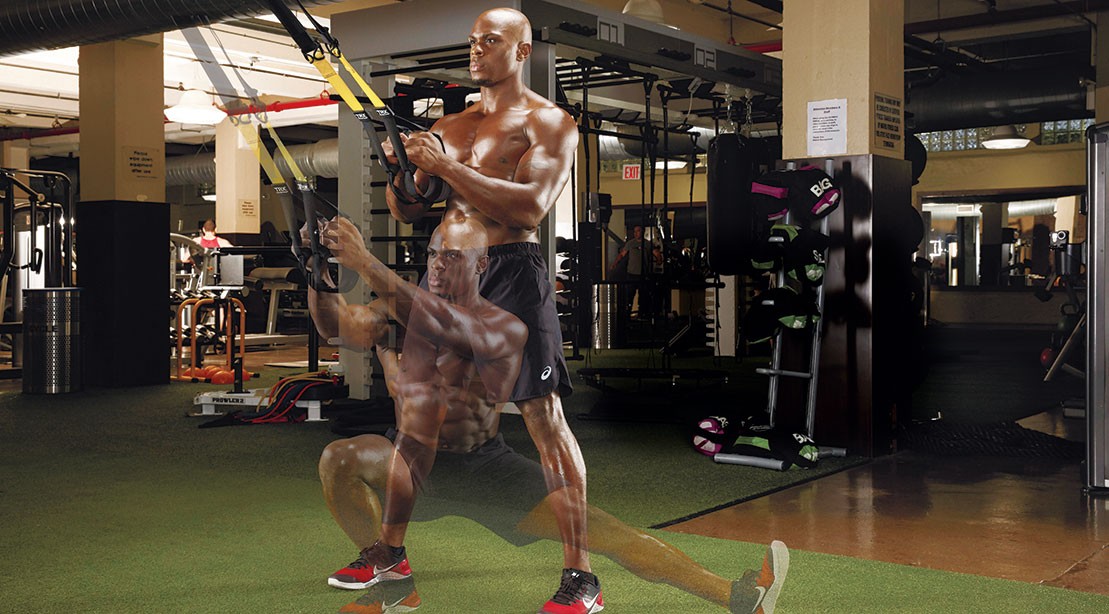
Your first glance at a suspension trainer—a long nylon strap, with handles on both ends, anchored to the ceiling with a carabiner at its center—probably won’t tempt you away from the iron-forged familiarity of a heavy barbell or dumbbell in your grasp. It seems more suited to gymnasts and Peter Parker wannabes than serious bodybuilders.
Well, we’re here to set you right: A suspension workout would kick Spider-Man’s ass. It did ours, after trying the workout below, stimulating muscles in a whole new way. It includes movements for legs, back, chest, delts, and arms, with nothing more than gravity and our own body weight as resistance. We suggest you take a second look, because this training tool can make your workouts harder and more effective.
What It Is
The original suspension exercise apparatus was designed in 1997 by a Navy SEAL squadron commander, Randy Hetrick, who was seeking a way to stay fit in the field. He later brought his invention to market, calling it the TRX (short for “total-body resistance exercise”). “It reflexively activates your core in all planes of motion and connects your torso and limbs as a coordinated system—which is how it works in real life,” Frankel says. By altering your body position, you can make exercises easier or harder, meaning there is no shortage of options for beginners to more advanced athletes.
What It Does
A suspension trainer can hit every muscle in the body and leave you just as sore as any typical bodybuilding workout—yes, even leg day. But perhaps its signature benefit is that no matter what body part you’re focused on, your midsection gets plenty of attention. (And, let’s be honest, most of us could use more ab work.)
Numerous studies have proven this core benefit, including an EMG (electromyography) study published in the Journal of Strength and Conditioning Research in November 2014 that showed increased rectus abdominis, external oblique, and erector spinae activation when a plank was performed with a TRX versus on the floor. Another study— published in the same journal in 2014—measured increased abdominal muscle activity during a suspended pushup compared with the move on a stable surface.
[RELATED1]
Pros of Suspension Exercise
- Offers a wide range of exercises.
Squats, rows, presses, curls, extensions, raises, something called the “Cossack”—a suspension-training system is versatile to the extreme. Chances are, if you can do it with a free weight, you can figure out a challenging variation with the suspension equipment. - Engages the whole body.
In addition to core activation, a suspension device “functionally integrates the entire posterior chain,” Frankel says. That means it hits the rear delts, traps, external obliques, spinal erectors, glutes, hamstrings, and calves during most exercises. - Can be used almost anywhere.
You can hook it to a door, a pole, a pullup bar, the top of a squat rack. With your own suspension system—which you can get for under $100 for a basic setup to $249 for an advanced system—you can ensure you never miss another workout, whether at home or on the road.
Cons of Suspension Exercise
- There’s a learning curve.
Even if you’ve been lifting for years, your first time trying suspension moves will probably feel awkward—like, awful-first-date awkward. That’s because you’ll be engaging a number of stabilizing muscles that may not get too much attention during a traditional weight-training workout. Know that it can get frustrating as you test out the basic movements and get acclimated. - You might need some expert help.
“As with any piece of training equipment, there are some easy-to-get-started-with moves, like rows and presses,” Frankel says. “Maintaining good posture and alignment will ensure a safe and effective experience.” But if you want to get serious, he suggests finding a trainer who’s certified specifically on suspension training techniques. (Try your own local gym.)
[RELATED2]
How to Use It
“A beginner or deconditioned individual can get a great workout using body weight,” Frankel explains. “But at some point you’re going to need additional external resistance to continue to see gains in strength and size.” That may mean combining free-weight moves with suspension exercises in one killer session.
“With a prime mover like pecs, for instance, performing a suspended chest flye paired with dumbbell or barbell chest presses will stimulate extreme fiber recruitment due to the range of motion and integration of the core, shoulders, and back, which have to actively stabilize on the straps,” Frankel says.
Numerous types of suspension movements can be slotted into your workouts, whether as a warmup, a finisher, or anywhere within the meat of your routine. “It will be a real ‘oh, damn’ moment for anyone who thinks these straps can’t build muscle,” Frankel adds. “Adding in some instability and focused high-tension, full-body activation is no joke.”
No comments:
Post a Comment